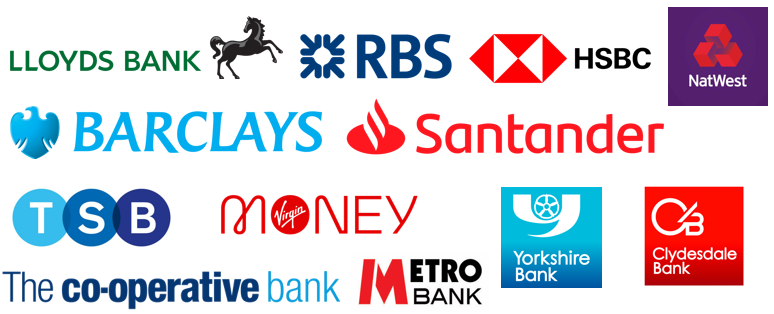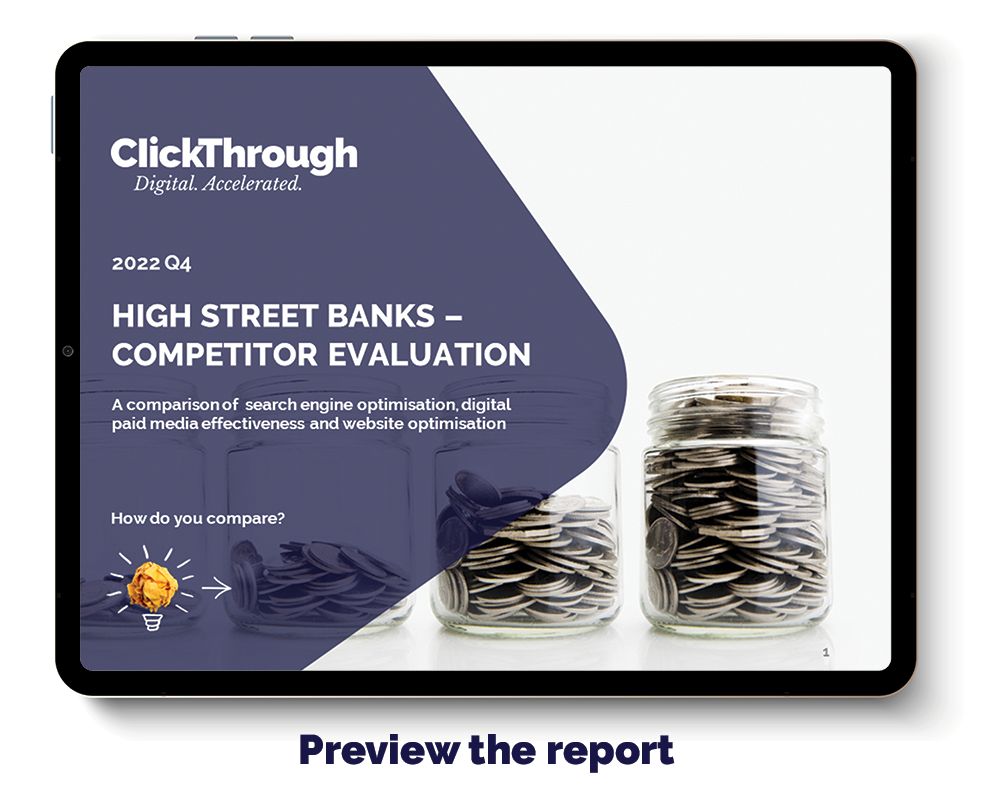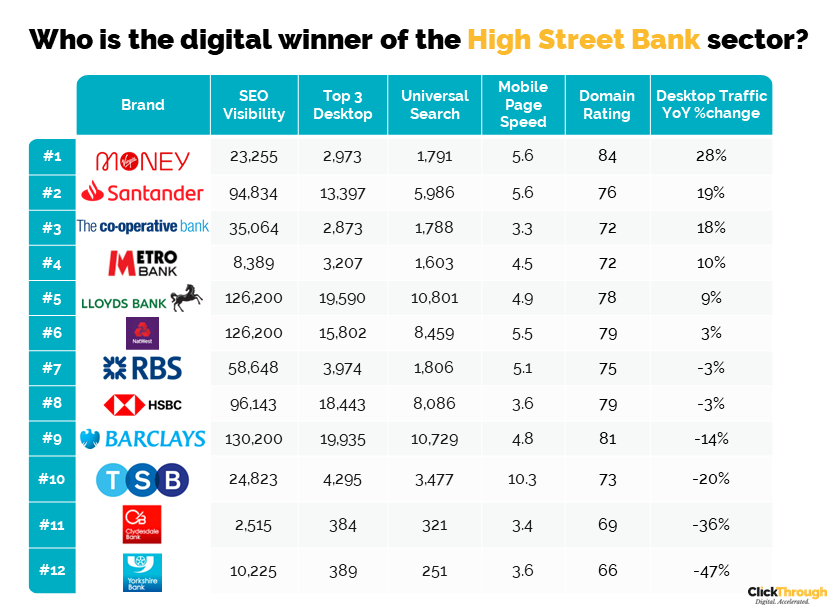The Q4 2022 benchmarking report for UK high street banks has just been published. Learn how the top 12 UK high street banks perform across the digital space.
The latest Q4 2022 benchmarking report for UK high street banks has just been published. It covers the largest 12 national high street banks, including Lloyds, NatWest, Barclays, Royal Bank of Scotland, HSBC, Metro, Santander, TSB, The Co-operative Bank, Virgin Money, Yorkshire Bank, and Clydesdale. 
The research gives an inside track on who is winning the biggest share of voice online, and quantifies the gaps, risks and missed opportunities for other high street banks to win brand exposure locally, online and in-store footfall. The report highlights quick wins that will improve enquiries from your online strategy and identifies the barriers that may be reducing your site’s ability to optimise digital performance.
 To see a preview and contents page of the Q4 report, click here. To get a copy of the full report and the key takeaways, please complete the enquiry form or schedule a call.
To see a preview and contents page of the Q4 report, click here. To get a copy of the full report and the key takeaways, please complete the enquiry form or schedule a call.
You can also find out how these 12 high street banks performed against last quarter, by revisiting our Q3 report round-up.
What The Industry Research Report Covers
The 70+ pages of research benchmarks each retailer based on 50+ metrics and indicators of successful digital strategy, including organic visibility, domain authority, paid media ads, conversion performance, technical performance, site speed, universal search, content, social ads, accessibility, and mobile performance.
Driving Optimal ROAS from Paid Media Channels
Some of the leading players in the space are high spenders on paid media channels such as Google, Bing & Facebook - but have a poor or sub-optimal conversion improvement strategy. Without an optimised, sophisticated conversion strategy that maximises the conversion rate, the return on investment is unsustainable or will under-perform. Scaling spend on paid media is not achievable unless the conversion rate delivers optimal performance in the sector. Some in the space have paid media spend levels from 30k+ per month but dedicate minimal resources and budgets to conversion testing. Given the cost per clicks on ad networks will continue to rise, we recommend spending at least 10% of your paid media budget on ongoing conversion optimisation testing schedules to ensure your paid media ROI maintains long term viability, competitive advantage, and sustainability.
Technical Website Compliance
Savvy digital marketers know that having a technically sound website is an essential component of a successful fully integrated digital strategy - plus a site capable of maximising conversion performance.
Many of the UK high street banks have varying degrees of technical errors that will be hindering organic traffic and conversion performance. An example here is Virgin Money’s 99 4XX errors, this is the highest of all the high street banks. We saw in Q3 TSB had the highest number of errors with 78 4xx errors, however this looks to have gotten slightly better in Q4 with TSB now hitting 68 4xx errors. All companies seeing errors need to continue looking into the causes, as these will be making their site difficult to navigate and frustrating to use. This is likely to also give a negative impression of the brand to the user, who need to trust them to provide an excellent level of service.
Site Speed & Conversion Rate Performance
When 62% of consumers are less likely to convert if they have a negative mobile site experience, ensuring that your site is quick and easy to load makes a significant improvement on your overall conversion rates.
In our research in Q3, we saw that only two of the twelve high street banks were within the ‘okay’ range of 50-89, however, in Q4 we can see that these have now improved with three of the high street banks within the range, with the scores ranging from 65 to 13. In Q3 we saw that TSB had an impressive score of 91, however, TSB has now dropped to only 48. TSB needs to look into what the cause of this drop is.
Building Competitive Advantage with Domain Authority
Domain authority is an essential metric for measuring the effectiveness of SEO performance, and helps create a reliable overall gage of how effective your site is at achieving organic traffic, i.e. ‘free’ traffic that isn’t gained through sponsored ads.
A ‘good’ DA really comes down to how your competitors are performing, however it’s generally considered average between 40 and 50, good between 50 and 60, and excellent above 60. In Q4 we saw the DA range from 84 to 66. We can see compared to Q3 that Yorkshire Bank are still the lowest scoring company, with the same score of 66.
Organic Performance – Mobile & Desktop
A strong organic performance is strategically important as it ensures your site ranks above competitors for key, transactional keywords. When 93% of your customers won’t go past the first page of Google, your absence or lack of targeting for essential keywords will cost you conversions.
We looked at how all twelve high street banks have performed compared to last year. Continuous improvement and optimisation is also needed to secure traffic year on year. We discovered that only threeof the high street banks in our report have gained organic mobile traffic year on year. The Co-operative Bank, Virgin Money, and Santander are the only companies seeing growth in mobile traffic compared to last year.
Universal Search Opportunity
Google Universal Search Results is an evolving opportunity to make your pages visible on a SERP (Search Engine Results Page). Universal results often appear before traditional listings and are eye-catching for users. Universal search results refer to rankings on a SERP that are not the traditional ‘blue line’ Google link, and a retailer can appear for universal search results without being strong in standard rankings.
We could see that People Also Ask was the highest used universal search feature, with Barclays taking the top spot reaching 4,700 results. Some companies are underusing most universal search feature options, with some companies only seeing a handful of results. Those getting a small number of results need to work towards the numbers their competitors are achieving.
The Longtail Keyword Opportunity
Longtail keywords are often considered high intent and potentially more likely to convert as a searcher is being more specific. Optimising for longtail keywords also puts your content strategy in a strong position to rank for retailer new search terms as they enter Google’s index.
TSB are still ranking for little longtail keywords within the top 20 when compared with their competitors, as we also pointed out in Q3. They should be looking at how to improve their rankings on existing longtail keywords, but also at how they can expand their strategy to include new specific search terms.
Facebook Adverts
With the number of Facebook users in the United Kingdom (UK) forecast to hit over 42 million users by 2022, it is not surprising that companies have jumped at the opportunity to advertise on the social media platform. Facebook’s UK digital advertising revenue has been estimated to have breached 2.6b GB pounds in 2019.
Below, we can see examples of Santander’s Facebook ads. The use of images of their customers ‘adventures’, along with clear CTA’s and their recognisable brand colours, make the advert eye-catching to scrolling social media users.

Top Social Shares & Content
When it comes to social media and on-site content strategies, it is important to release content that has a longer shelf life. An article is considered 'Evergreen' if it has maintained its relevancy to an audience for longer. It's great for your retailer engagement, but great for Google too, who will recognise content which achieves traffic over a long period of time.
We saw in our research that many of the high street banks are falling behind on content creation. We can see that Metro are lagging in content over 2022, when compared with their competitors. This is a missed opportunity for these brands, who could be sharing content, getting involved in the social media crazes, and sharing information about special offers.
Website Readability & Accessibility
20% of people in the UK have a disability – 2 million of which are people living with sight loss. In addition, 1 in 12 men and 1 in 200 women have some degree of colour vision deficiency. When websites are not designed to meet these needs, retailers lose customer interest as they turn elsewhere.
All of the high street banks appear to be struggling with accessibility within their sites, with all twelve seeing an array of errors, contrast errors and alerts. In Q3 we saw that Yorkshire Bank had 44 contrast errors and 109 alerts, we’ve seen little improvement in Q4 with Yorkshire Bank still hitting 44 contrast errors and 103 alerts. We would expect all the high street banks that are seeing accessibility issues to be reviewing and optimising their accessibility.
Q4 2022 WINNERS LEADERBOARD
For a glance into just 6 of the metrics, we evaluated these top 12 high street banks on, check out our quick-look table below;

We can see that compared to Q3, there has been changes across the board. Yodel jumping from #7 to #1, Barlcays dropping from #1 to #9. To see the Q3 report and leaderboard, click here.
GET THE FULL 70-PAGE Q4 2022 REPORT
To get a copy of the full report, please complete the enquiry form. If you want to talk to us about accelerating your digital performance, please call us on 01543 410014 or schedule a call with Mike Movassaghi.
Photo by Sarah Agnew on Unsplash





Let's be social
Join our growing social communities to learn more about the benefits of digital marketing and the people who make us tick.